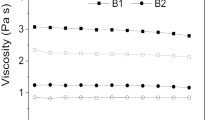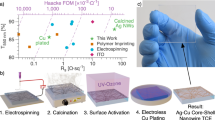Abstract
Poly(phthalaldehyde) (pPHA) and copolymers with aliphatic aldehydes were investigated as dry-develop, positive-tone photoresist. Exposure of the films loaded with a photoacid generator to 248 nm radiation creates an acid that depolymerizes the polymer into volatile monomers, allowing the development of features by vaporization rather than solution-based processes. By controlling the acid content, the vaporization rate of the reaction products, and the degree of liquid formation of the decomposed polymer, control of spatial resolution and the quality of polyaldehyde dry-develop photoresist was achieved. Heat, vacuum, and forced convection were evaluated as development techniques in determining the resist sensitivity, contrast, and resolution. Forced convection of heated nitrogen was the most controllable development method for pPHA films. Five-micron lines and spaces were printed. Poly(aldehyde) copolymer resins had slightly lower spatial resolution but were able to be developed faster due to higher vapor pressure of the depolymerized monomers. Cold photo-exposures and development were used to prevent detrimental liquid formation of the decomposed copolymers. In addition to exploring new dry-development methods that have not been tested before, these findings offer insights into designing better material systems and optimizing processes for dry-develop photoresists.










Similar content being viewed by others
References
S. Campbell: Engineering at the Micro and Nanoscale, 4th ed. (Oxford University Press, New York, 2013).
A.R. Dick, W.K. Bell, B. Luke, E. Maines, B. Mueller, B. Rawlings, P.A. Kohl, and C. Grant Willson: High aspect ratio patterning of photosensitive polyimide with low thermal expansion coefficient and low dielectric constant. J. Micro/Nanolith. MEM. 15, 033503 (2016).
B.K. Mueller, J.M. Schwartz, A.E. Sutlief, W.K. Bell, C.O. Hayes, E. Elce, C.G. Willson, and P.A. Kohl: Chemically amplified, positive tone, polynorbornene dielectric for microelectronics packaging. ECS J. Solid State Sci. Technol. 4, N3001 (2015).
H. Ito and C.G. Willson: Chemical amplification in the design of dry developing resist materials. Polym. Eng. Sci. 23, 1012 (1983).
C.G. Willson, R.R. Dammel, and A. Reiser: Photoresist materials: a historical perspective. In Proceedings of SPIE 3050, Metrology, Inspection, and Process Control for Microlithography XI, Vol. 3050 (1997).
J.M.J. Fréchet, T.G. Tessier, and F.M. Houlihan: Approaches to the design of radiation-sensitive polymeric imaging systems with improved sensitivity and resolution. J. Electrochem. Soc. 133, 181 (1986).
H. Ito and R. Schwalm: Thermally developable, positive resist systems with high sensitivity. J. Electrochem. Soc. 136, 241 (1989).
J.M.J. Frechet, J. Fahey, C.G. Willson, T. Iizawa, K. Igarashi, and T. Nishikubo: Synthesis of polyformals and their use as dry-developing imgaing systems. Proc. ACS Div. Polym. Mater. Sci. Eng. 60, 174 (1989).
F.M. Houlihan, F. Bouchard, J.M.J. Fréchet, and C.G. Willson: Thermally depolymerizable polycarbonates. 2. Synthesis of novel linear tertiary copolycarbonates by phase-transfer catalysis. Macromolecules 19, 13 (1986).
E. Uzunlar, J. Schwartz, O. Phillips, and P.A. Kohl: Decomposable and template polymers: Fundamentals and applications. J. Electron. Packag. Trans. ASME 138, 1 (2016).
L. Chen, Y.-K. Goh, K. Lawrie, B. Smith, W. Montgomery, P.A. Zimmerman, I. Blakey, and A.K. Whittaker: Non-chemically amplified resists for 193-nm immersion lithography: influence of absorbance on performance. Adv. Resist Mater. Process. Technol. XXVII 7639, 76390V (2010)
K.J. Lawrie, I. Blakey, J.P. Blinco, H.H. Cheng, R. Gronheid, K.S. Jack, I. Pollentier, M.J. Leeson, T.R. Younkin, and A.K. Whittaker: Chain scission resists for extreme ultraviolet lithography based on high performance polysulfone-containing polymers. J. Mater. Chem. 21, 5629 (2011).
M.J. Bowden and L.F. Thompson: Electron irradiation of poly(olefin sulfones). Application to electron beam resists. J. Appl. Polym. Sci. 17, 3211 (1973).
E. Reichmanis and A.E. Novembre: Lithographic resist materials chemistry. Annu. Rev. Mater. Sci. 23, 11 (1993).
F. Wang and C.E. Diesendruck: Polyphthalaldehyde: Synthesis, derivatives, and applications. Macromol. Rapid Commun. 39, 1 (2018).
K. Hatada, T. Kitayama, S. Danjo, H. Yuki, H. Aritome, S. Namba, K. Nate, and H. Yokono: Highly sensitive self developing electron-beam resist of aldehyde copolymer. Polym. Bull. 8, 469 (1982).
K. Nate, T. Inoue, H. Yokono, and K. Hatada: Highly sensitive self-developing soft X-ray resists of silicon-containing aldehyde copolymers and sensitive novolac-based composite resists containing aldehyde copolymer. J. Appl. Polym. Sci. 35, 913 (1988).
P.C. Paul, A.W. Knoll, F. Holzner, M. Despont, and U. Duerig: Rapid turnaround scanning probe nanolithography. Nanotechnology 22, 275306 (2011).
J.-F. de Marneffe, B.T. Chan, M. Spieser, G. Vereecke, S. Naumov, D. Vanhaeren, H. Wolf, and A.W. Knoll: Conversion of a patterned organic resist into a high performance inorganic hard mask for high resolution pattern transfer. ACS Nano 12, 11152 (2018).
F. Holzner, P. Paul, M. Despont, L.L. Cheong, J. Hedrick, U. Dürig, and A. Knoll: Thermal probe nanolithography: in-situ inspection, high-speed, high-resolution, 3D. In 29th Eur. Mask Lithogr. Conf., Vol. 888605 (2013).
J.M. Schwartz, O. Phillips, A. Engler, A. Sutlief, J. Lee, and P.A. Kohl: Stable, high-molecular-weight Poly(phthalaldehyde). J. Polym. Sci. Polym. Chem. 55, 1166 (2017).
J.M.J. Frechet, F. Bouchard, E. Eichler, F.M. Houlihan, T. Iizawa, B. Kryczka, and C.G. Willson: Thermally depolymerizable polycarbonates V. acid catalyzed thermolysis of allylic and benzylic polycarbonates: A new route to resist imaging. Polym. J. 19, 31 (1987).
A. Engler, O. Phillips, R.C. Miller, C. Tobin, and P.A. Kohl: Cationic copolymerization of o-Phthalaldehyde and functional aliphatic aldehydes. Macromolecules 52, 4020 (2019).
Acknowledgement
The authors gratefully acknowledge the financial support of the U.S. Department of Education Graduate Assistance in Areas of National Need (GAANN) program at the Georgia Institute of Technology (Award #P200A180075), and Georgia Tech President’s Undergraduate Research Award.
Author information
Authors and Affiliations
Corresponding author
Rights and permissions
About this article
Cite this article
Kohl, P.A., Engler, A., Tobin, C. et al. Influence of material and process parameters in the dry-development of positive-tone, polyaldehyde photoresist. Journal of Materials Research 35, 2917–2924 (2020). https://doi.org/10.1557/jmr.2020.243
Received:
Accepted:
Published:
Issue Date:
DOI: https://doi.org/10.1557/jmr.2020.243




